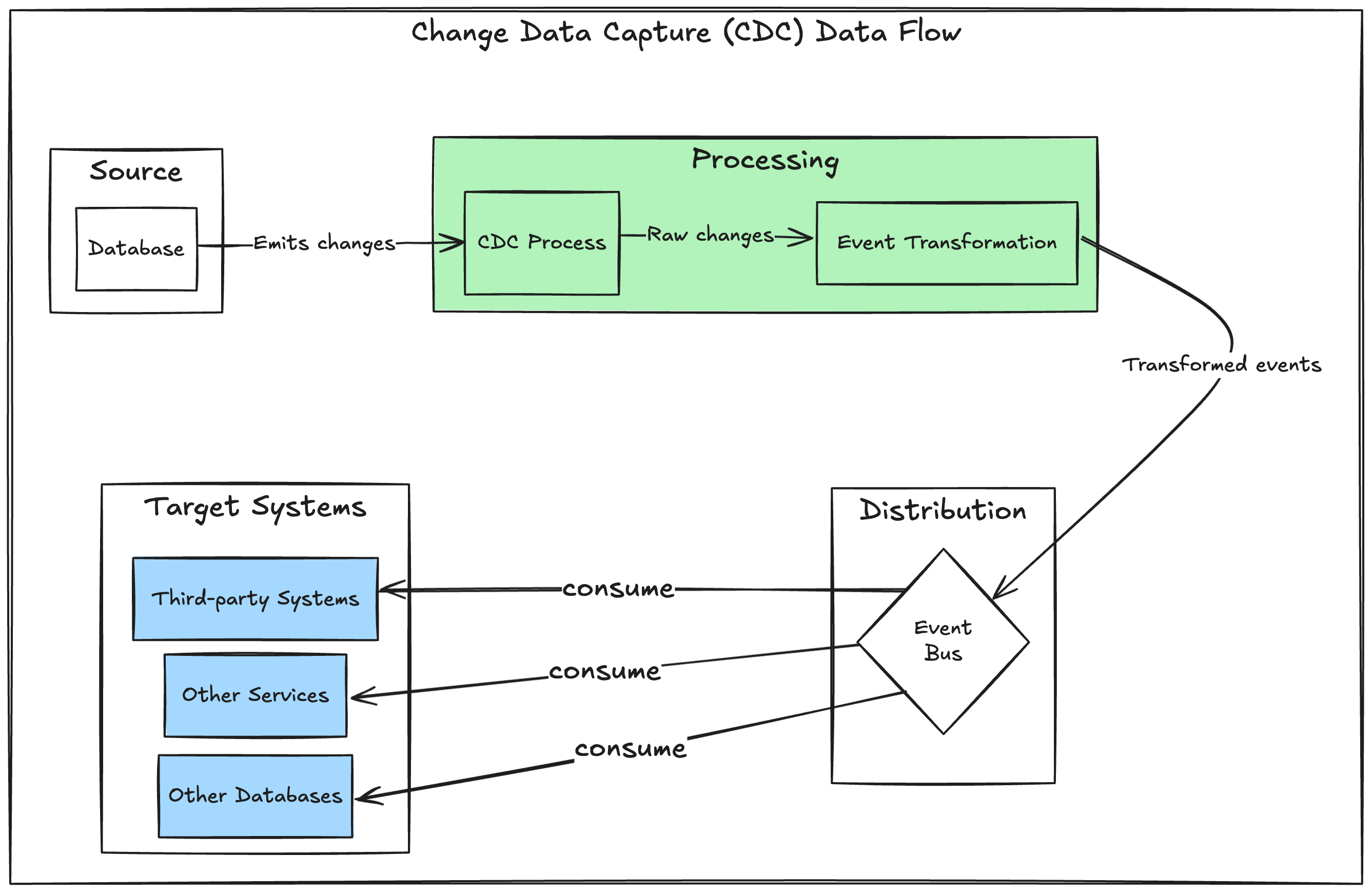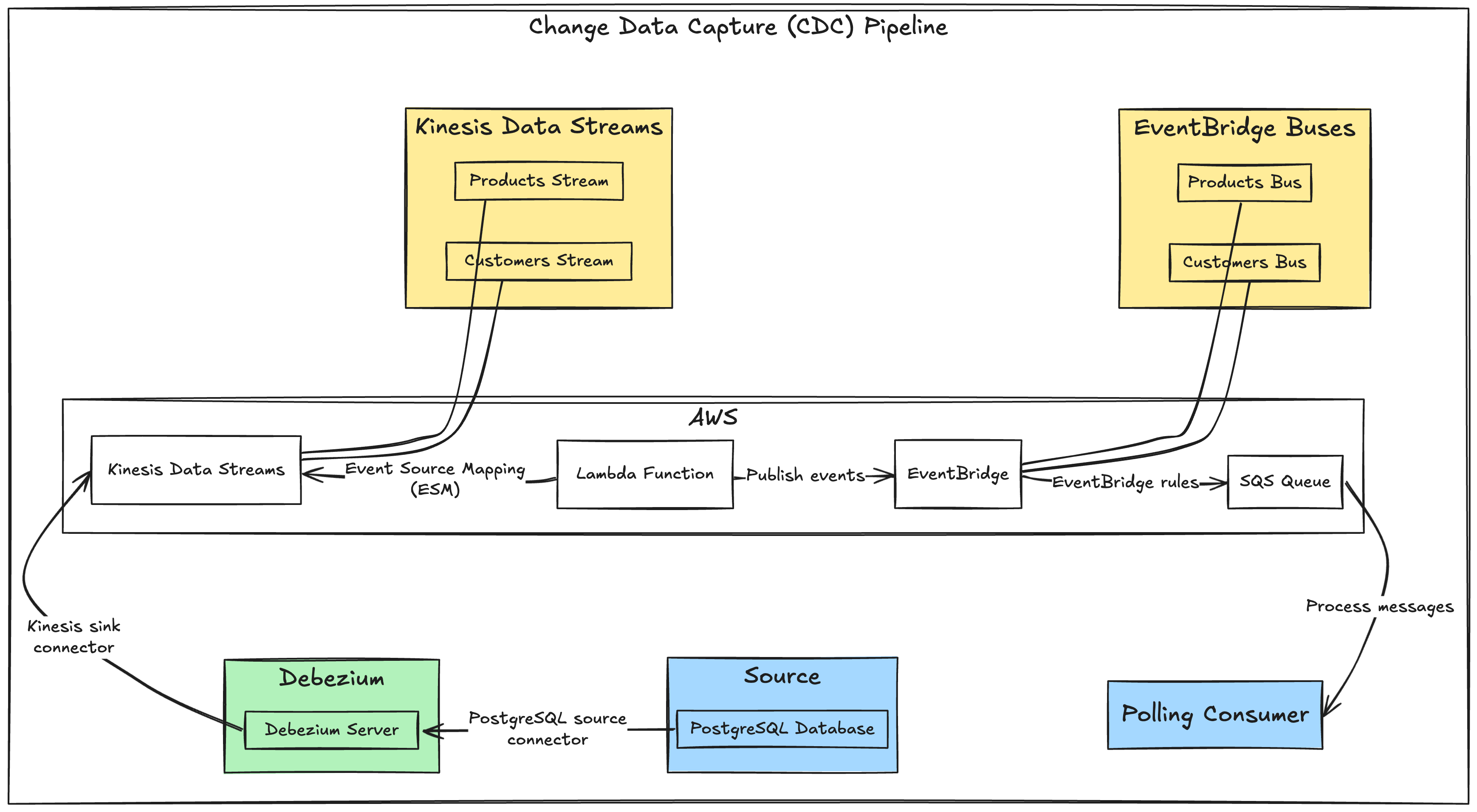This article will explore how to build a Change Data Capture (CDC) pipeline to capture data changes in a PostgreSQL database and propagate those changes in real-time using Debezium, AWS Kinesis, and EventBridge. We will cover the fundamental concepts of CDC, describe its use cases, and walk through a complete implementation with code examples.
TThe code snippets provided here are simplified for demonstration purposes. The complete implementation is in this repository.
What is Change Data Capture (CDC)?
Change Data Capture (CDC) is the process of identifying and capturing changes made to a database — such as INSERT, UPDATE, or DELETE operations — and delivering those changes to downstream systems in real time.
Originally, CDC emerged as an alternative to traditional batch-based ETL (Extract, Transform, Load) jobs. Today, it is the standard approach for real-time data replication pipelines because of its efficiency and minimal latency.
Use cases for CDC
CDC can be applied to a wide range of use cases, including:
- Real-time stream processing for event-driven applications (the focus of this article).
- Synchronizing data across distributed systems.
- Replicate data changes for disaster recovery.
- Automating cache invalidation when data changes.
- Audit trails and compliance tracking.
- Optimizing ETL jobs by processing only changed data.
- Keeping CRM systems updated in real-time.
and more…
How does CDC work?
There are three primary approaches for implementing CDC
Trigger-Based CDC
In a trigger-based CDC system, database triggers execute custom logic to log changes into a separate table.
- Pros: Simple to implement.
- Cons: Performance overhead due to additional writes for each operation.
Below is an example of capturing data changes using a trigger in PostgreSQL.
-- Create the trigger
CREATE OR REPLACE FUNCTION customers_trigger_function()
RETURNS TRIGGER AS $$
BEGIN
INSERT INTO data_change_log (table_name, operation, timestamp, data)
VALUES ('customers', TG_OP, NOW(), NEW);
RETURN NEW;
END;
$$ LANGUAGE plpgsql;
-- Attach the trigger function to the table
CREATE TRIGGER customers_trigger
AFTER INSERT OR UPDATE OR DELETE
ON customers
FOR EACH ROW
EXECUTE FUNCTION customers_trigger_function();
Timestamp-based CDC
This method periodically queries the database for records modified since the last capture point using a modified_at column.
- Pros: Simpler than log-based CDC.
- Cons: Adds query overhead and requires custom logic to handle
DELETEoperations.
Below is an example of capturing data changes using the modified_at timestamp column and a checkpoints table to track previous capture times.
Below is an example of querying modified records and using a checkpoints table to track previous capture times.
CREATE OR REPLACE FUNCTION get_modified_customers_since_last_capture()
RETURNS TABLE (id INTEGER, name VARCHAR(255), email VARCHAR(255), created_at TIMESTAMP, modified_at TIMESTAMP) AS $$
#variable_conflict use_column
DECLARE
latest_capture_time TIMESTAMP;
BEGIN
-- Fetch the latest capture time from the checkpoints table and store it in the variable
SELECT last_capture_timestamp INTO latest_capture_time
FROM checkpoints
WHERE table_name = 'customers';
-- Capture changes in the 'customers' table since the latest capture change
RETURN QUERY
SELECT id, name, email, created_at, modified_at
FROM customers
WHERE modified_at > latest_capture_time;
END;
$$ LANGUAGE plpgsql;
SELECT * FROM get_modified_customers_since_last_capture();
Log-based CDC
Log-based CDC reads database transaction logs (e.g., PostgreSQL WAL logs) to identify changes.
It reads the transaction logs of the source database, parsing and interpreting the log entries to identify changes. It then extracts relevant information from the logs, such as the affected data and the type of operation performed, to replicate the changes to the target system.
- Pros: Minimal performance impact since no additional queries are needed.
- Cons: Requires parsing and interpreting database logs.
Below is an example of using PostgreSQL logical decoding, which relies on Write-Ahead Logging (WAL), to capture the logical changes made to the data.
-- Create a slot named 'test_slot' using the output plugin 'test_decoding'
SELECT * FROM pg_create_logical_replication_slot('test_slot', 'test_decoding');
-- Insert rows in the customers table
INSERT INTO customers
VALUES (DEFAULT, 'Oliver Alsop', 'oliver@mail.com', DEFAULT, DEFAULT),
(DEFAULT, 'Trevor Baker', 'trevor@mail.com', DEFAULT, DEFAULT);
-- Fetch changes from the 'test_slot' logical replication slot
SELECT * FROM pg_logical_slot_get_changes('test_slot', NULL, NULL);
lsn | xid | data
-----------+-------+---------------------------------------------------------
0/BA5A688 | 10298 | BEGIN 10298
0/BA5A6F0 | 10298 | table inventory.customers: INSERT: id[integer]:1006 name[character varying]:'Oliver Alsop' email[character varying]:'oliver@mail.com' created_at[timestamp without time zone]:'2024-04-11 00:21:33.970134' modified_at[timestamp without time zone]:'2024-04-11 00:21:33.970134'
0/BA5A6F0 | 10298 | table inventory.customers: INSERT: id[integer]:1006 name[character varying]:'Trevor Baker' email[character varying]:'trevor@mail.com' created_at[timestamp without time zone]:'2024-04-11 00:22:33.970134' modified_at[timestamp without time zone]:'2024-04-11 00:22:33.970134'
0/BA5A8A8 | 10298 | COMMIT 10298
(4 rows)
Event-Centric CDC, why?
CDC positions data stores as first-class citizens in the Event-Driven Architecture (EDA). The benefit comes from enabling the database to function as an event producer without adding event production overhead or requiring changes to the service that manages the database.
Imagine a scenario with multiple services, each responsible for a specific business domain. By leveraging CDC, the data stores of these services can emit change events directly to a domain event bus or message bus, allowing other systems to react to these events as needed.

Event transformation is crucial in this setup to transform events using a versioned data contract that hides the internal structure of the database schema. This prevents tight coupling between downstream systems and the database schema, allowing modifications to the schema without affecting them.
Tooling
Open-Source
One of the most prominent open-source options is Debezium as it offers various database source connectors such as MongoDB, MySQL, and PostgreSQL, among others. It also supports a range of sink connectors including Kafka, Redis, Kinesis, HTTP API, and more.
Commercial
There are many options available like Google Datastream and AWS Database Migration Service, among others which offer a fully managed CDC engine.
Their pricing varies based on data volume, rows replicated, connectors, and operational runs.
Implementation
In this example implementation, I use:
- PostgreSQL serves as the source database.
- Debezium server captures data changes.
- AWS Kinesis streams change events.
- AWS Lambda processes and transforms events via event source mapping (ESM).
- AWS EventBridge acts as the event bus.
- AWS SQS queue serves as the final consumer target.
I also use LocalStack to simulate AWS services locally, leveraging its initialization hooks feature to provision necessary AWS resources with bash scripts.

PostgreSQL database
The source database consists of four tables: products, stock, customers, and orders.
-- Create the schema that we'll use to populate data and watch the effect in the WAL
CREATE SCHEMA inventory;
SET search_path TO inventory;
-- Create 'products' table
CREATE TABLE products (
id SERIAL NOT NULL PRIMARY KEY,
name VARCHAR(255) NOT NULL,
description VARCHAR(512),
created_at TIMESTAMP NOT NULL DEFAULT CURRENT_TIMESTAMP,
modified_at TIMESTAMP NOT NULL DEFAULT CURRENT_TIMESTAMP
);
-- Create 'stock' table
CREATE TABLE stock (
product_id INTEGER NOT NULL PRIMARY KEY,
quantity INTEGER NOT NULL,
created_at timestamp NOT NULL DEFAULT CURRENT_TIMESTAMP,
modified_at timestamp NOT NULL DEFAULT CURRENT_TIMESTAMP,
FOREIGN KEY (product_id) REFERENCES products(id)
);
-- Create 'customers' table
CREATE TABLE customers (
id SERIAL NOT NULL PRIMARY KEY,
name VARCHAR(255) NOT NULL,
email VARCHAR(255) NOT NULL UNIQUE,
created_at TIMESTAMP NOT NULL DEFAULT CURRENT_TIMESTAMP,
modified_at TIMESTAMP NOT NULL DEFAULT CURRENT_TIMESTAMP
);
-- Create 'orders' table
CREATE TABLE orders (
id SERIAL NOT NULL PRIMARY KEY,
quantity INTEGER NOT NULL,
customer_id INTEGER NOT NULL,
product_id INTEGER NOT NULL,
created_at TIMESTAMP NOT NULL DEFAULT CURRENT_TIMESTAMP,
modified_at TIMESTAMP NOT NULL DEFAULT CURRENT_TIMESTAMP,
FOREIGN KEY (customer_id) REFERENCES customers(id),
FOREIGN KEY (product_id) REFERENCES products(id)
);
Debezium server
I use Debezium’s PostgreSQL source connector and Kinesis sink connector to stream data change messages from the PostgreSQL database to a Kinesis data stream.
The application.properties file contains the source and sink configurations for the Debezium server.
# Sink config
debezium.sink.type=kinesis
debezium.sink.kinesis.region=us-east-1
debezium.sink.kinesis.endpoint=http://localstack:4566
# Source config
debezium.source.connector.class=io.debezium.connector.postgresql.PostgresConnector
debezium.source.offset.storage.file.filename=data/offsets.dat
debezium.source.offset.flush.interval.ms=0
debezium.source.database.hostname=postgres
debezium.source.database.port=5432
debezium.source.database.user=postgres
debezium.source.database.password=postgres
debezium.source.database.dbname=inventory_db
debezium.source.topic.prefix=kinesis
debezium.source.schema.include.list=inventory
debezium.source.table.include.list=inventory.products,inventory.customers
debezium.source.column.exculde.list=inventory.products.modified_at,inventory.customers.modified_at
debezium.source.plugin.name=pgoutput
debezium.source.database.history=io.debezium.relational.history.FileDatabaseHistory
debezium.source.database.history.file.filename=data/history.dat
AWS Kinesis data stream
Create two Kinesis streams named kinesis.inventory.products and kinesis.inventory.customers to receive data change messages from the Debezium server.
Debezium requires stream names to follow the pattern prefix.schema.table and these streams must be pre-created since Debezium does not handle stream creation.
# Create a 'kinesis.inventory.products' Kinesis stream
awslocal \
kinesis \
create-stream \
--shard-count 1 \
--stream-name kinesis.inventory.products
# Create a 'kinesis.inventory.customers' Kinesis stream
awslocal \
kinesis \
create-stream \
--shard-count 1 \
--stream-name kinesis.inventory.customers
AWS Eventbridge bus
Create two event buses named products and customers to store data change events from the Kinesis kinesis.inventory.products and kinesis.inventory.customers streams respectively (more about this in the Lambda ESM part).
# Create a 'products' EventBridge bus
awslocal \
events \
create-event-bus \
--name products
# Create a 'customers' EventBridge bus
awslocal \
events \
create-event-bus \
--name customers
AWS Lambda function
Create a Lambda function to process records from Kinesis streams, transform them, and publish them to the appropriate event bus by creating an event source mapping (ESM) between the Lambda function and the Kinesis stream.
# Create a 'kinesis-esm' Lambda function
awslocal \
lambda \
create-function \
--function-name kinesis-esm \
--zip-file fileb://lambda/package.zip \
--runtime python3.9 \
--handler lambda/main.handler \
--role arn:aws:iam::000000000000:role/lambda-role \
--environment Variables="{PRODUCTS_EVENT_BUS_NAME=products,CUSTOMERS_EVENT_BUS_NAME=customers}"
# Create an event source mapping between the Lambda function and the 'products' Kinesis stream
awslocal \
lambda \
create-event-source-mapping \
--function-name kinesis-esm \
--event-source-arn arn:aws:kinesis:us-east-1:000000000000:stream/products \
--starting-position TRIM_HORIZON \
--maximum-retry-attempts -1 \
--batch-size 10
# The ESM for the 'customers' Kinesis stream is the same as above.
# ...
Below is a snipped version of the Lambda handler logic:
try:
for record in event["Records"]:
encoded_record_data = record["kinesis"]["data"]
decoded_record_data = base64.b64decode(encoded_record_data).decode("utf-8")
record_data = json.loads(decoded_record_data)
# Example event source ARN: "arn:aws:kinesis:us-east-1:XXXX:stream/stream-name"
stream_name = record["eventSourceARN"].split("/")[1]
detail_type = stream_event_detail_type_mapping[stream_name]
bus_name = stream_event_bus_mapping[stream_name]
transformed_event = _transform_event(record_data)
event_entry = {
"Source": stream_name,
"DetailType": detail_type,
"Detail": json.dumps(transformed_event),
"EventBusName": bus_name,
"Time": str(datetime.now()),
}
event_entries.append(event_entry)
response = eventbridge.put_events(Entries=event_entries)
except Exception as e:
logger.error(e, exc_info=True)
raise e
AWS SQS queue
Create an SQS FIFO queue, to preserve messages order, named data-change to receive events from both the product and customers event buses through an EventBridge rule.
# Create a 'data-change' FIFO SQS queue
awslocal \
sqs \
create-queue \
--queue-name data-change.fifo \
--attributes FifoQueue=true,ContentBasedDeduplication=true
# Create an EventBridge rule to forward all events from the 'products' bus
awslocal \
events \
put-rule \
--name forward-to-sqs \
--event-pattern '{"source":[{"prefix":""}]}' \
--event-bus-name products \
--state ENABLED \
--output text \
--query 'RuleArn'
# The 'customers' EventBridge bus rule is the same as above.
# ...
# Associate the 'forward-to-sqs' SQS queue target to the above rule
awslocal \
events \
put-targets \
--rule forward-to-sqs \
--event-bus-name products \
--targets '[ {
"Id": "Target1",
"Arn": "arn:aws:sqs:us-east-1:000000000000:data-change.fifo",
"SqsParameters": {
"MessageGroupId": "Group1"
}
}
]'
# The target assoicated with the 'customers' EventBridge bus rule is the same as above.
# ...
Below is a snipped version of the SQS queue consumer logic
while True:
response = sqs.receive_message(QueueUrl=queue_url)
for sqs_message in response.get("Messages", []):
message = SQSMessage.model_validate(sqs_message)
bus_event = EventBridgeEvent.model_validate_json(message.body)
logger.info("Received event detail-type: %s, source: %s", bus_event.detail_type, bus_event.source)
change_data_event = DebeziumEvent.model_validate(bus_event.detail)
logger.info("Message id '%s' - Event 'before': %s", message.id, change_data_event.payload.before)
logger.info("Message id '%s' - Event 'after': %s", message.id, change_data_event.payload.after)
_delete_message(message.receipt_handle)
logger.info("Message with id '%s' deleted successfully.", message.id)
Below are sample logs from the SQS consumer container, showcasing a change data event for an insert operation on the products table.
2024-04-13 23:13:56 21:13:56.908 [main] INFO consumer - Received event detail-type: ProductDataChangeEvent, source: kinesis.inventory.products
2024-04-13 23:13:56 21:13:56.908 [main] INFO consumer - Data change event - before: None
2024-04-13 23:13:56 21:13:56.909 [main] INFO consumer - Data change event - after: {'id': 101, 'name': 'scooter', 'description': 'Small 2-wheel scooter', 'created_at': 1712934636990657, 'modified_at': 1712934636990657}
Conclusion
Change Data Capture (CDC) provides a flexible and scalable way to capture and propagate data changes in real-time.
By routing data change events to an event bus, we unlock new possibilities for downstream systems, allowing for seamless integration with analytics and data warehousing, as well as enabling real-time stream processing needed to build fraud detection, dynamic pricing, and various other applications.

Comments